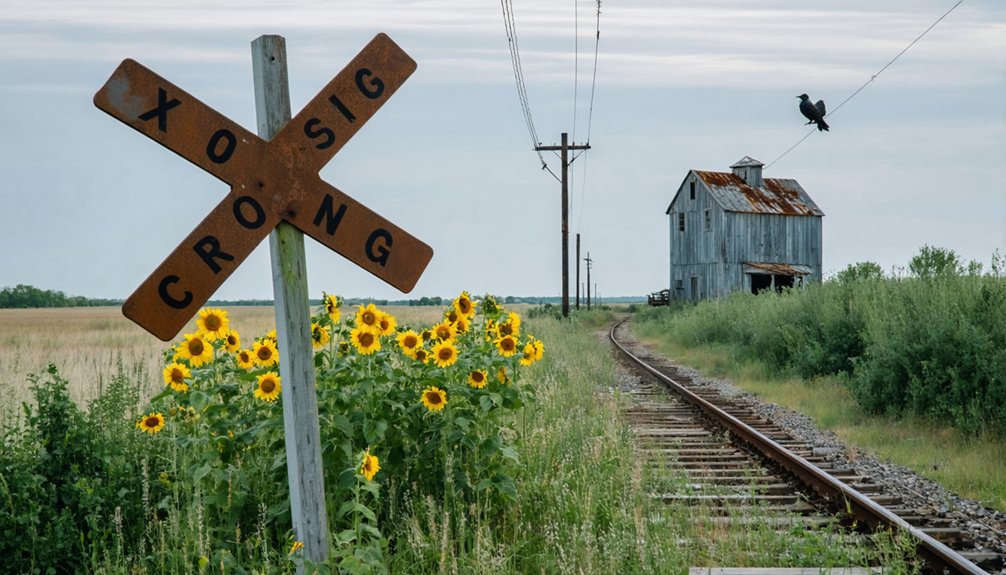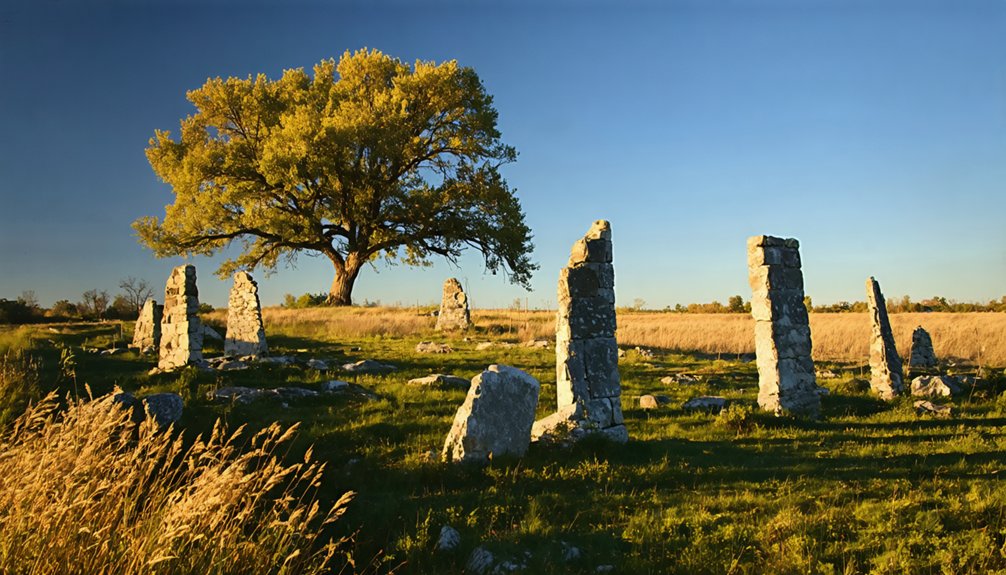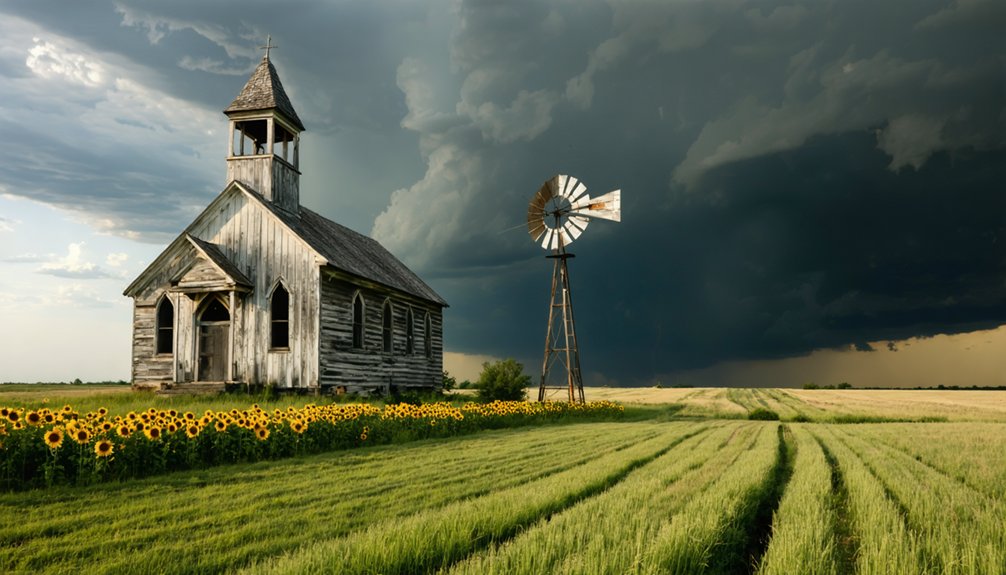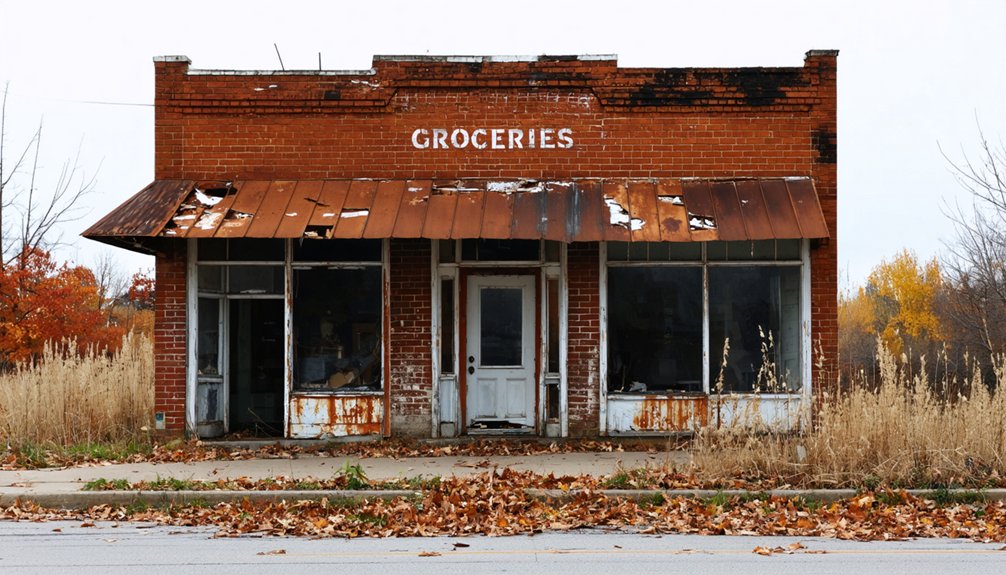You’ll discover Yatton, Iowa, as one of the state’s submerged ghost towns, now resting beneath Lake Red Rock. This once-thriving settlement emerged after the Black Hawk Purchase of 1832, with pioneers establishing homesteads near freshwater streams. While it flourished through mining and lumber in the late 1800s, the town’s isolation from railroads and evolving transportation networks led to its decline. The weathered cemetery and over 1,200 excavated artifacts tell a deeper story of this lost community.
Key Takeaways
- Yatton was a 19th-century Iowa settlement that declined after being bypassed by railroads and facing economic challenges from larger commercial centers.
- The town’s remains now lie beneath Lake Red Rock, with no intact buildings visible above the water level.
- Archaeological excavations revealed over 1,200 artifacts, showing both pioneer settlement and earlier Native American Woodland Culture occupation.
- The settlement’s decline accelerated when coal mines closed and the transition from steam to diesel eliminated the need for fuel stops.
- Only a weathered cemetery with mid-19th century graves remains as a visible link to Yatton’s historical existence.
The Pioneer Settlement Years
While Native American tribes like the Sauk, Fox, Iowa, and Sioux originally called the region home, European-American settlement of Yatton began in earnest after the Black Hawk War of 1832.
You’d have found the first settlers facing numerous pioneer challenges as they carved out their lives in the prairie landscape. Unlike the familiar forests of the East, they’d to adapt to a tree-scarce environment, though eastern Iowa’s hardwoods provided essential building materials. Just as modern websites require user verification, early settlers had to prove their claims to land agents.
Settlement adaptations included crafting their own tools and rope from local materials like flax and hemp. You would’ve seen simple wooden plows breaking the tough prairie sod, while handmade harrows and rakes helped prepare fields for spelt wheat and barley cultivation.
Pioneer settlers ingeniously fashioned essential tools and farming implements from local materials, transforming raw prairie into cultivated fields through hard work and resourcefulness.
The settlers formed tight-knit support networks, sharing labor and resources to overcome the harsh winters that often decimated their cattle herds.
Life on the Lower Hill Slopes
If you’d walked through Yatton’s lower hill slopes in its early days, you’d have found pioneer families strategically positioning their homesteads near natural springs and sheltered areas of the Loess Hills.
The wind-deposited soil, while challenging to farm, supported essential crops like corn and squash, which settlers cultivated alongside hunting deer and small game from the surrounding wilderness. Like the early Woodland Indians, these settlers adapted to the land by gathering wild berries and seeds to supplement their diets. The deep soil layers created by ancient wind deposits made the region uniquely fertile despite its challenging terrain.
The slopes’ unique geological features influenced where settlers built their homes, with most choosing protected locations that offered both access to water and natural barriers against harsh weather patterns.
Early Settlement Patterns
The gentle slopes of Yatton’s lower hills attracted the first European-American settlers in the years following the Black Hawk Purchase of 1832. You’d have found these pioneering families strategically positioning their homesteads near freshwater streams, taking advantage of the well-drained, fertile soil for their crops and livestock.
Settlement dynamics centered around these natural advantages, with families building log cabins and frame houses from local timber. Like many areas across Iowa, these settlers were part of the territorial expansion that would eventually lead to Iowa’s statehood in 1846.
You’d have seen small clusters of homes emerging, connected by paths that followed the natural contours of the hillsides. Community interactions flourished at trading posts and communal buildings, where settlers – often sharing similar ethnic backgrounds – gathered to trade goods and strengthen social bonds.
These early residents planted familiar crops like corn and beans, adapting traditional farming methods to their new environment. The settlers’ agricultural practices mirrored those found in other pioneering communities like Council Bluffs, which began as a vital trading post between settlers and local tribes.
Natural Landscape Influences
Natural features of Yatton’s lower hill slopes shaped every aspect of pioneer life, offering settlers an ideal balance of protection and productivity.
You’d find these gentle inclines provided natural shelter from harsh winds while maintaining proper drainage for your crops. The landscape influence extended beyond mere farming – it determined where you’d build your home and how you’d manage your land.
Like the old 1885 schoolhouse that still stands today, early settlers strategically positioned important community buildings to maximize the natural advantages of the terrain.
The rich loamy soils supported your agricultural adaptation efforts, letting you grow diverse crops while practicing contour plowing to prevent erosion.
You’d benefit from the springs and seeps at slope bases for reliable water, while staying safely above flood-prone lowlands. The scattered oak and hickory groves supplied your building materials and firewood, while also sheltering game animals that supplemented your food supply. Similar to other Iowa towns like Mount Air, the community maintained a low crime rate due to its tight-knit rural character.
Economic Rise and Decline
During Iowa’s late 19th century mining boom, Yatton emerged as a promising settlement built upon the twin pillars of coal extraction and lumber production.
You’d have found a bustling community where miners and lumberjacks worked side by side, with the town’s post office establishment in 1888 marking its economic peak.
Despite early signs of community resilience, Yatton’s fate hung precariously on these extractive industries. Similar to Iowa’s town of Buxton, where coal demand decline led to its abandonment, Yatton’s local businesses struggled to maintain profitability against larger commercial centers in neighboring counties.
Without economic diversification, Yatton became vulnerable to market shifts and competition from neighboring settlements.
When coal-powered trains gave way to diesel locomotives, demand plummeted. The mines began closing, sending workers elsewhere in search of opportunities.
Like many of Iowa’s resource-dependent towns, Yatton’s decline proved swift and irreversible, leading to its eventual abandonment.
Daily Life in Early Yatton
Life in early Yatton painted a portrait of close-knit community bonds, where you’d find neighbors gathering on front porches and children playing freely in the streets.
You could set your watch by the seasonal rhythms, as farmers tended their fields and community gatherings centered around planting and harvest times.
Walking through town, you’d notice the bell-towered churches standing proud against the Iowa sky, serving as both spiritual havens and social hubs.
Bell towers rose like beacons across Yatton’s skyline, where churches united the faithful and forged lasting community bonds.
Your daily routine would include stopping to chat with fellow residents outside the local shops, while horse-drawn wagons passed by on unpaved streets.
In the neighborhoods, you’d see homes built with sturdy wood frames and welcoming front doors, designed to foster the connections that made Yatton’s population of 329 feel like one extended family.
Transportation’s Impact on the Town

While Yatton initially flourished as a mid-19th century settlement near river and trail access, the town’s fate would ultimately be sealed by its isolation from evolving transportation networks.
You’d have witnessed the town’s steady decline as railroads bypassed Yatton in favor of neighboring communities, cutting off essential freight and passenger connections that could’ve sustained growth.
As transportation routes shifted and new economic patterns emerged, you would’ve seen businesses shuttering and families relocating to better-connected towns.
The rise of automobile travel dealt another blow – without proper road infrastructure, Yatton couldn’t compete.
When the shift from steam to diesel eliminated the need for water and coal stops, you’d have watched the final nail driven into Yatton’s coffin, transforming a once-promising settlement into another Iowa ghost town.
Notable Landmarks and Structures
As you explore Yatton’s remaining landmarks, you’ll encounter the historic schoolhouse with its distinctive bell tower standing as a symbol of the town’s educational heritage.
You’ll find evidence of mid-19th century settler homes and community buildings constructed primarily of local wood, though many now show the effects of time and abandonment.
The town cemetery, featuring Civil War-era headstones, serves as both a solemn memorial to Yatton’s original residents and an essential landmark for identifying the ghost town’s location.
Early Settlement Structures
Like many ghost towns scattered across Iowa’s landscape, historical records about Yatton’s early settlement structures remain remarkably sparse.
While you won’t find detailed documentation of Yatton’s settlement architecture today, the town likely followed typical patterns of early Iowa communities, where practicality shaped building designs.
Here’s what you would’ve found in a typical Iowa settlement of that era:
- Wooden structures built for durability against harsh prairie conditions
- Simple, functional buildings that served as homes and businesses
- Agricultural storage facilities supporting local farming practices
- Community gathering spaces like a general store or meeting hall
You’ll notice that, like many ghost towns, Yatton’s structural history has faded into obscurity, leaving us to piece together its story through our understanding of similar Iowa settlements from that pioneering period.
Remaining Building Foundations
The waters of Lake Red Rock now conceal most traces of Yatton’s structural heritage, with no intact buildings remaining from the original settlement.
You’ll find no visible remaining foundations of the town’s public structures above the lake level, as schools, churches, and the railway station were dismantled or submerged during the reservoir’s creation.
While some Iowa ghost towns retain brick silos and cellar holes of historical significance, Yatton’s agricultural and residential foundations have been lost to flooding and demolition.
Even the transportation infrastructure, including old Highway 14 and bridge foundations, was systematically removed.
The only tangible connections to Yatton’s past exist through historical markers near sites like Red Rock Cemetery, standing as silent witnesses to the community that once thrived here.
Cemetery and Burial Sites
Standing as one of the few tangible links to Yatton’s past, a weathered cemetery rests near the original townsite, its irregular layout bearing witness to generations of local history.
You’ll find field stone markers scattered throughout, reflecting early settler burial traditions and the simple dignity of pioneer life.
The cemetery’s powerful symbolism reveals itself through:
- Mid-19th century graves marking the community’s earliest pioneers
- Family plots, including suspected Milner family burials, showcasing generational ties
- Weathered stones telling stories of the town’s gradual decline
- Fragmented sections cut by modern roads and property lines
While nature slowly reclaims the grounds, these burial sites remain essential for genealogists and historians seeking to understand Iowa’s vanished communities and the lives of those who shaped them.
Archaeological Evidence Today
Modern excavations at Yatton’s archaeological site have revealed a fascinating window into ancient Native American life, with over 1,200 artifacts unearthed from the settlement.
Through careful artifact analysis, you’ll find evidence of a thriving Woodland Culture community that called this area home between 500-900 A.D. The discoveries include chert flakes from toolmaking, broken arrow points, and fragments of ceramic pottery that tell the story of their daily lives.
You can trace their seasonal patterns through the remnants they left behind, suggesting they’d spend roughly six months at a time here.
The presence of hematite, used for creating red pigments, and their burial customs paint a picture of a rich cultural life. These archaeological treasures continue to provide insights into how these early inhabitants lived and died.
Legacy in Washington County History

While many frontier settlements faded into obscurity, Yatton’s legacy endures as a poignant chapter in Washington County’s historical narrative.
You’ll find Yatton’s significance preserved in county records, where it serves as a symbol of pioneer ambitions and the pursuit of freedom on the American frontier.
The town’s historical impact is documented through:
- County histories that chronicle early settlement patterns and development
- Regional narratives highlighting the “last sixpence” phenomenon of frontier ventures
- Educational resources used to teach about 19th-century socio-economic transformations
- Historical records demonstrating how transportation shifts affected rural communities
Through these preserved accounts, you’re able to understand the broader story of Washington County’s evolution, as Yatton exemplifies the challenges and dreams that shaped Iowa’s settlement history.
Frequently Asked Questions
Were There Any Native American Settlements Near Yatton Before Pioneers Arrived?
While you’ll find Native American historical significance throughout Iowa, there aren’t any confirmed settlements specifically near Yatton, though tribes like the Meskwaki likely passed through the region’s waterways.
What Happened to the Last Families Who Lived in Yatton?
You’d find the last families of Yatton likely moved to larger Iowa towns during mid-20th century mechanization, seeking better opportunities as railroad importance diminished and agricultural communities declined, though specific records remain scarce.
Did Yatton Have Its Own Post Office During Its Existence?
You won’t find a post office in historical records – postal history shows no federal post office was ever established there, which limited the community impact and residents’ connections to surrounding areas.
Were There Any Famous Crimes or Notable Incidents in Yatton?
In a town that lasted less than a century, you won’t find any documented famous crimes or mysterious disappearances. Historical records show no unsolved cases or notable incidents during Yatton’s existence.
What Natural Resources or Minerals Were Found in the Yatton Area?
You’d have found rich lead and zinc deposits in the area’s dolomite bedrock, along with valuable industrial minerals like limestone, sand, and gravel. Local mines extracted these resources through commercial operations.
References
- https://freepages.history.rootsweb.com/~gtusa/usa/ia.htm
- https://kids.kiddle.co/List_of_ghost_towns_in_Iowa
- https://archive.org/download/historyofwashing01burr/historyofwashing01burr.pdf
- https://pubs.lib.uiowa.edu/annals-of-iowa/article/id/6960/download/pdf/
- https://iagenweb.org/ringgold/misc/ghostowns.html
- https://www.youtube.com/watch?v=eh_YlgRKjBU
- https://en.wikipedia.org/wiki/List_of_ghost_towns_in_Iowa
- http://genealogytrails.com/iowa/benton/abandoned_towns_info.htm
- https://pubs.lib.uiowa.edu/annals-of-iowa/article/id/13466/download/pdf/
- https://www.wessexarch.co.uk/our-work/yatton-trackway-past



